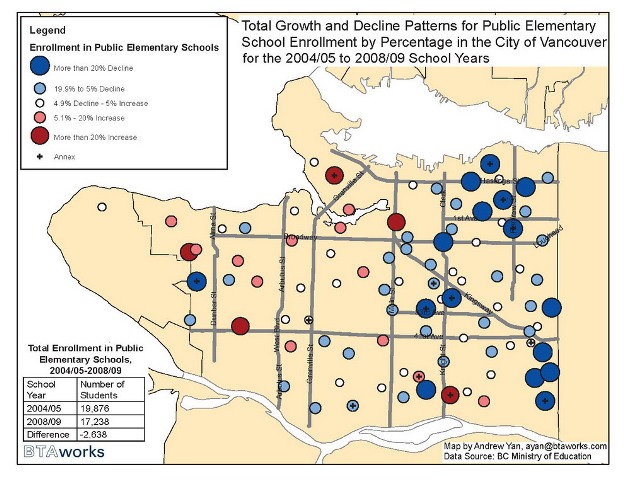The latest from Bing Thom’s home-grown R&D division, BTA Works.

Blue indicates a decline in enrolment.
Research reveals that since 2004, enrollment in public elementary schools in the City of Vancouver has declined by more than 13 percent (over 2,600 students) — a continuation of a steady enrollment decline since 2000.
While our overall City population has grown, it is surprising to discover that public elementary school enrollment has actually been on the decline by so much and for such a long time”, observed Andrew Yan, a BTAworks researcher and Urban Planner who wrote the brief. “Almost 20 percent of all Vancouver public elementary schools lost more than 20 percent of their students over the last 5 school years”.
More here.













This is a longstanding trend and one that even urban densification is likely to do little to reverse. In Greater Victoria for example, without in-migration, our population would have started to decline in 1994, the year deaths started to exceed births. Over the next 30 – 40 years our regional population is expected to grow by about 100,000, but of that number, 75% are expected to be over the age of 60, for a region with a median population already in the high 40’s. We will still need the school facilities and grounds, not for children, but for seniors centres.
Vancouver is also unaffordable for most families. Vancouver has failed at encouraging medium density housing that is both sustainable and family friendly. You can choose either a 1 or 2 bedroom condo in the $400k range or a single family lot in the $750k range. The median family income in the GVRD cannot support the mortgage required for a family to purchase a 1500 plus sq ft dwelling that is practical for a family with two children. Families with average income are forced to move to the suburbs because that is what they can afford yet the predominant view of Vancouverites is that those who live in the suburbs do so out of choice and the love of the automobile. If more medium density family options in the $350-400k range do not appear in the Vancouver real estate market, Vancouver risks becoming an elitist senior centric city.
This is also why Gregor Robertson won and why the left will keep winning in Vancouver, as most of the growth is east of Main St.
Corey, as a lifelong East Vancouverite, and a dad with a child in an east side school, I’d say be careful with your profiling of those of us over here. As a former city councillor, Gord can vouch that the line of who votes left/right doesn’t run down Ontario street.
Some of the strongest NPA support comes from the Killarney neighbourhood. Many who would have otherwise afforded on the west side (by your assumption “non-Vision” voters) are now moving east. Our household is not supportive of Vision, nor are many of my neighbours.
An analysis of 2008 voting patterns will reveal that the west side still voted in higher numbers than in the east, but many either stayed home or didn’t want to support Peter Ladner.
As for Andy’s very interesting study, there is more than meets the eye. Many parents are driving their kids out of catchment and over to west side schools. The threat to the east side is driven, in part, by an open catchment policy.
This is a very interesting topic that reveals a lot about our changing city, and I look forward to future installments.
Corey: the blue circles mean decline. Most of the decline is east of Main Street.
It would be interesting to see how much of each school’s enrollment is cross-boundary.
Interesting to note that downtown has such a significant INCREASE in enrollment.
Just of note, this post seems contrary to this map: http://regardingplace.com/?p=5770
It’s made from info from Chad Skelton’s blog here: http://communities.canada.com/vancouversun/blogs/parenting/archive/tags/childstats/default.aspx
The basic deal is that younger children especially are a higher proportion of the population in the eastern half of Vancouver, (while it’s reversed for older children) which goes against the school results. Makes me wonder if parents are simply crossing boundary lines in large numbers. Makes me also wonder whether such a policy that allows boundary crossing should even exist, as it tends to disadvantage those students who remain there and who are less mobile.
JJ is right, the issue is price. And the high cost of living in Vancouver, and to some extent Burnaby as well, is the REAL reason for sprawl in Surrey, Langley, Maple Ridge, etc. Blaming that migration on bridges and freeways, most of them yet unbuilt, and about to be tolled when they are built, is kind of funny really.
Maybe we need to wait another five years to see if this is a trend or a demographic and statistical blip.
In some of those neighbourhoods with the big blue dots, I challenge you to try to get a spot in a pre-school or daycare for a child under 5. The wait lists are huge.
In my immediate area, I can count on one hand the number of school-age children (as of the 2008-2009 year). I can count dozens under the age of 5.
Another possible reason for the declining enrollment in East Vancouver public schools are the new private schools like Stratford Hall as well as the buses to places like Waldorf in North Van — and the fact that many East Van families today can afford private school education if their catchment school is not a high performer.